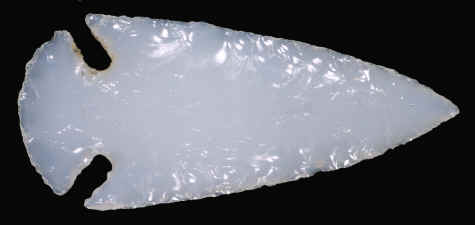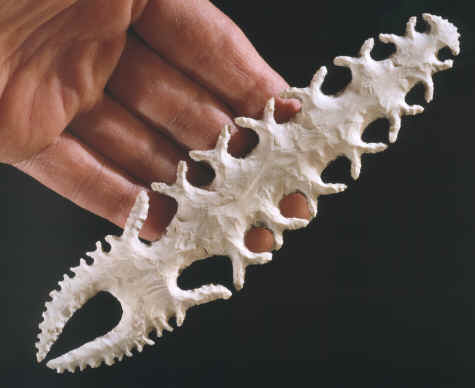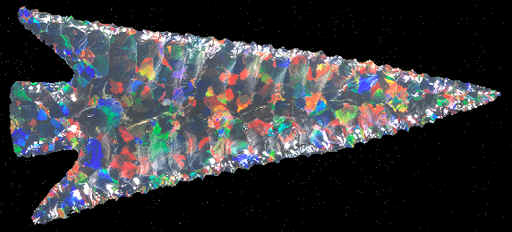|
|
|
Native American Indians began Flintknapping stone tools in North America sometime before 14,000 years ago. European Americans began flintknapping in North America for the "fake" commercial market, in volume, by the late 1800’s. Most of these so-called "spurious flints" were ancient points that were re-chipped into fanciful forms. Professor Thomas Wilson, of the Smithsonian Institution, wrote in 1888 "From these original and genuine forms the manipulator has made his curious forms. The originals were worth, say, two cents apiece, but after being subjected to his adroitness, their price would be increased to fifty or seventy-five cents. A fine speculation!" In 1898, the editor of "The American Archaeologist," Dr. J. F. Snyder wrote "We must admit that they are exceeding well made, and prove that stone chipping is not a lost art; but that certain unscrupulous white persons of the present day have, by long continued practice, become as expert in it as were any of the ancient aborigines." The history of modern flintknapping in the United States is legendary. In the early to mid 1900’s there were people like Mack Tussinger, with his famous Indian mound, from which he sold elaborate eccentrics for most of his life. Or Bryan Reinhardt who produced tens of thousands of the now famous "gray ghosts" he made from sawn slabs of Edwards Plateau chert with some type of mechanical lever devise he invented himself. Richard Warren was another early knapper who produced large numbers of the beautiful flake-over-grinding points that he was so famous for. These and other early "vocational" flintknappers were controversial in their time. But they are part of the American flintknapping legend and their points are becoming more and more collectable. |
|
|
"The shaping of stone by fracture processes is one of the earliest as well as one of the most important arts of primitive men." This statement from a 1912 publication of the Smithsonian Institution "The Handbook of American Indians North of Mexico" defines it quite well. The word "art" in this sentence can be used to define what is actually going on with today's modern flintknappers. These people are duplicating virtually all of the different types of ancient stone artifacts that have been found throughout the world. Whether they are Clovis or Folsom points from North America, Neolithic Daggers from Europe or Gerzean Knives from North Africa. The difference that separates the past from the present is that the stone artifacts being made today are no longer used on a daily basis to survive but "mainly" for enjoyment as a hobby that produces a unique piece of art. |
|
|
Flintknapping as a hobby is growing very fast. The first "knap-ins," where flintknappers began to hold meetings, began about twenty-five years ago when there were very few knappers around. The numbers of flintknappers began to expand rapidly by the late 80’s and early 90’s as more flintknapping demonstrations, books, tapes and newsletters on the subject began to appear. Today, there are "knap-ins" every weekend during the warmer months and these events will sometimes draw hundreds of people. They are the best places to observe the different craftsmen’s techniques and communicate with people who have similar interests. Knap-ins are also good places to trade for various knapping materials and just have a good time. |
|
|
|
|
A growing appreciation for finely crafted flintknapped art pieces has developed over the last ten to fifteen years. These exquisite art forms cover a wide spectrum of skill and ingenuity. Some knappers are making extremely exotic stone blades that are hafted in ultra fancy handles. Others are making finely crafted eccentrics of every conceivable shape. But the majority of knappers are producing copies of ancient projectile points and knife forms. A select few of these craftsmen are producing pieces that are far more skillfully flaked than the work of ancient knappers. These pieces can be larger, thinner, and more colorful and have almost perfect flaking patterns. Many knappers are making their points out of the rarest and highest quality stone available, which greatly adds to their artistic appeal. Some of the most beautiful points have been made from exotic materials like synthetic opal, fiber-optics and multi-colored glass. Collecting signed copies from the artist of finely crafted modern-made stone artifacts will continue to grow as it has with any other art form, if it's well done. Without a doubt, it is a very unique hobby and craft with an extraordinary history. |
|
|
"REFERENCES" 2005, Bostrom, Peter A., "A Short History of Flintknapping," Modern Lithic Artists Journal, Vol. 1 January, pp. 3-6. 1898,
Snyder, J. F., "The American Archaeologist, Vol. 2 Part II,"
"Counterfeiting Indian Relics," pp. 131-133. |
|




